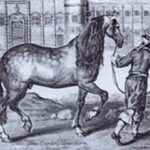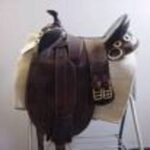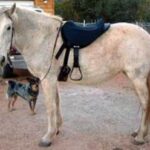Centuries ago, when there were hardly any roads and many people had to spend long hours in the saddle, breeding horses with smooth, comfortable gaits were paramount. Many of these breeds ambled instead of trotted, including many of the Spanish breeds that were brought over to North America. Nowadays, with roads and cars, horses are bred more for speed. They normally walk, trot and canter and do not amble. One of the few breeds that does still amble and does it naturally is the Racking horse .
Brief History
Racking horses are derived from the Tennessee Walking Horse, which was developed in America’s southern plantations. These horses were highly valued for their type of amble known as a rack or single-foot. Even though a horse puts down one hoof at a time in a rack, they can move faster than horses of other breeds at a trot. Some Racking horses have been clocked at over 25 miles per hour.
This gait, at slower speeds, can be maintained by both horse and rider for a long stretch of time. Many horses that racked of several breeds were nearly wiped out after first the Civil War and then the advent of the car. Breeders of Tennessee Walkers decided that the future of their breed would be in showing. Unfortunately, over the years, very cruel methods have been used by some trainers in order to artificially induce a rack.
But there were still horses that could rack without the use of cruel, artificial methods. In 1971, breeders and owners of these horses decided to form their own breed called the Racking horse. They were so successful that by 1975, the Racking horse was made the official horse breed of the state of Alabama.
In 1971, the breed’s stud books were open to any non-draft or non-pony breed that could naturally perform the rack. The individual horse was judged before registration could be given. By 1990, the stud book had closed. But a foal of two Racking horses still has to show that rack before he or she can be registered.
General Appearance
Racking horses resemble a leaner version of a Tennessee Walking Horse. They come in all horse colors except Appaloosa patterns (and there is a separate registry for them.) Racking horses average 15.2 hands high and 1,000 pounds, but the size can vary from 14.3 to 16 hands. They have long shoulders, a full mane and tail but often a short, silky coat.
Racking horses are gentle, sensible creatures that are generally easier to get along with than a human being. They are highly trainable because they like human company and like to please. The Racking horse is generally considered safe for riders of all ages and abilities and can also work in harness.
Additional Refernces:
“Storey’s Illustrated Guide to 96 Horse Breeds of North America.” Judith Dutson. Storey Publishing, 2005.
State Symbols USA. “Alabama State Horse – Racking Horse.” http://www.statesymbolsusa.org/Alabama/State-horse-racking.html
High Performance Hoof Care, LLC. “Big Lick – The Greatest Freak Show on Earth.” Vickey Marie Hollingsworth, DAEP. http://www.hphoofcare.com/lick.html
Racking Horse Breeders’ Association of America. “History.” http://www.rackinghorse.com/history.html





